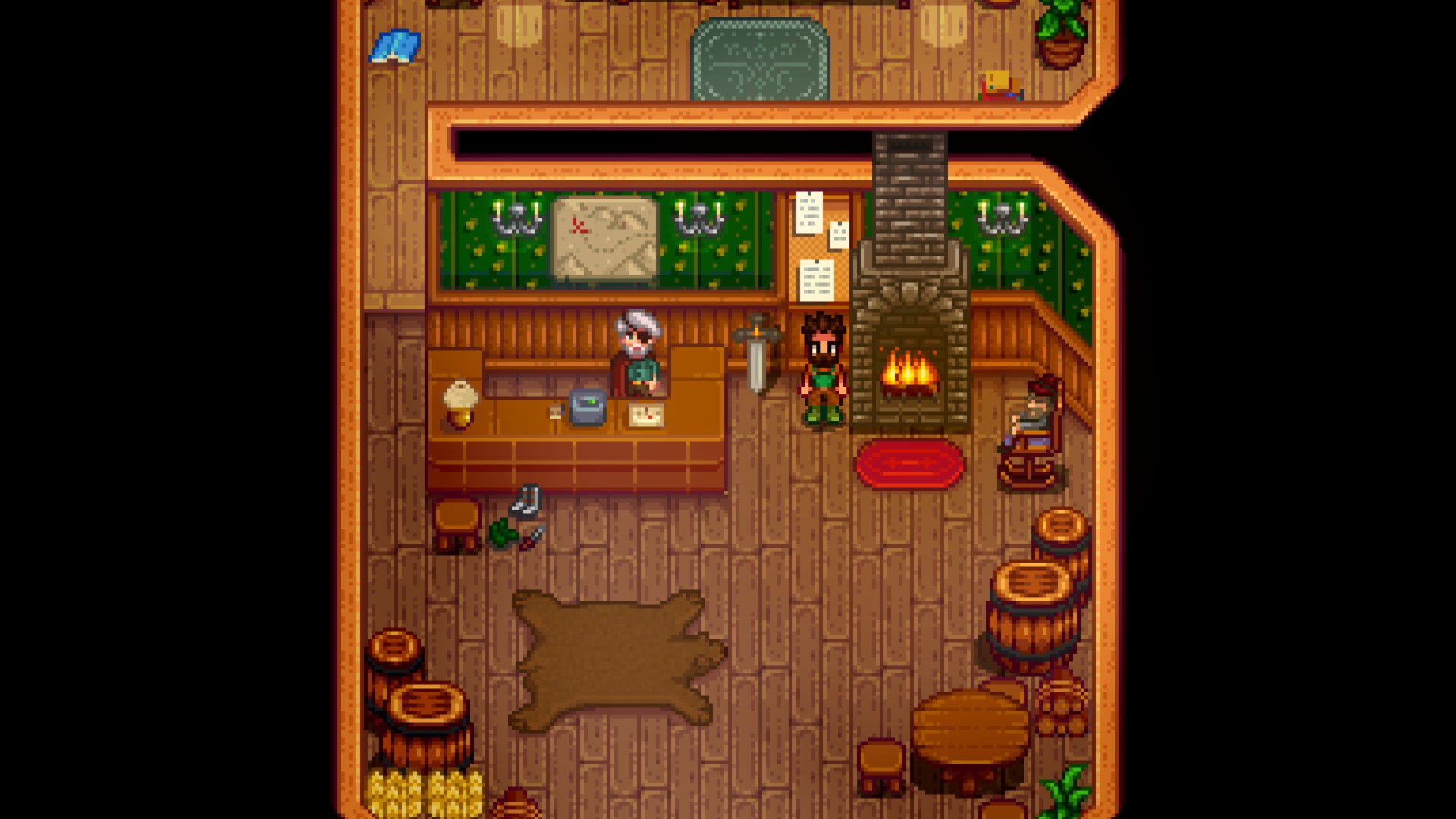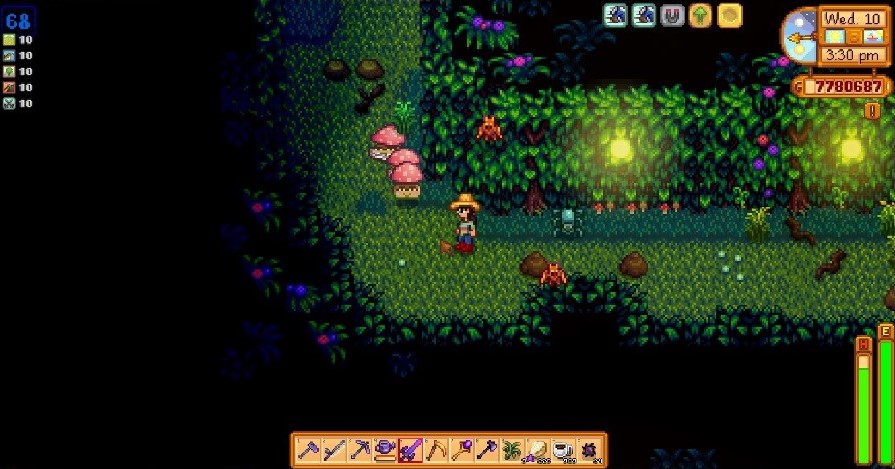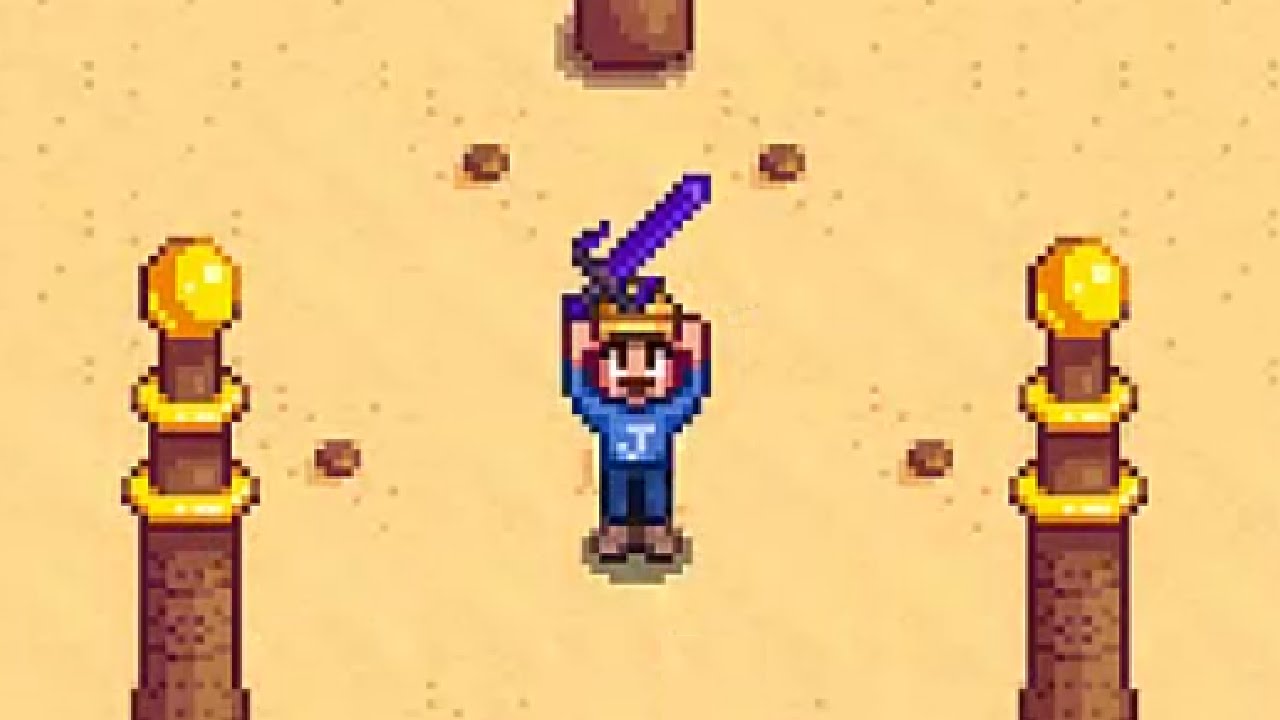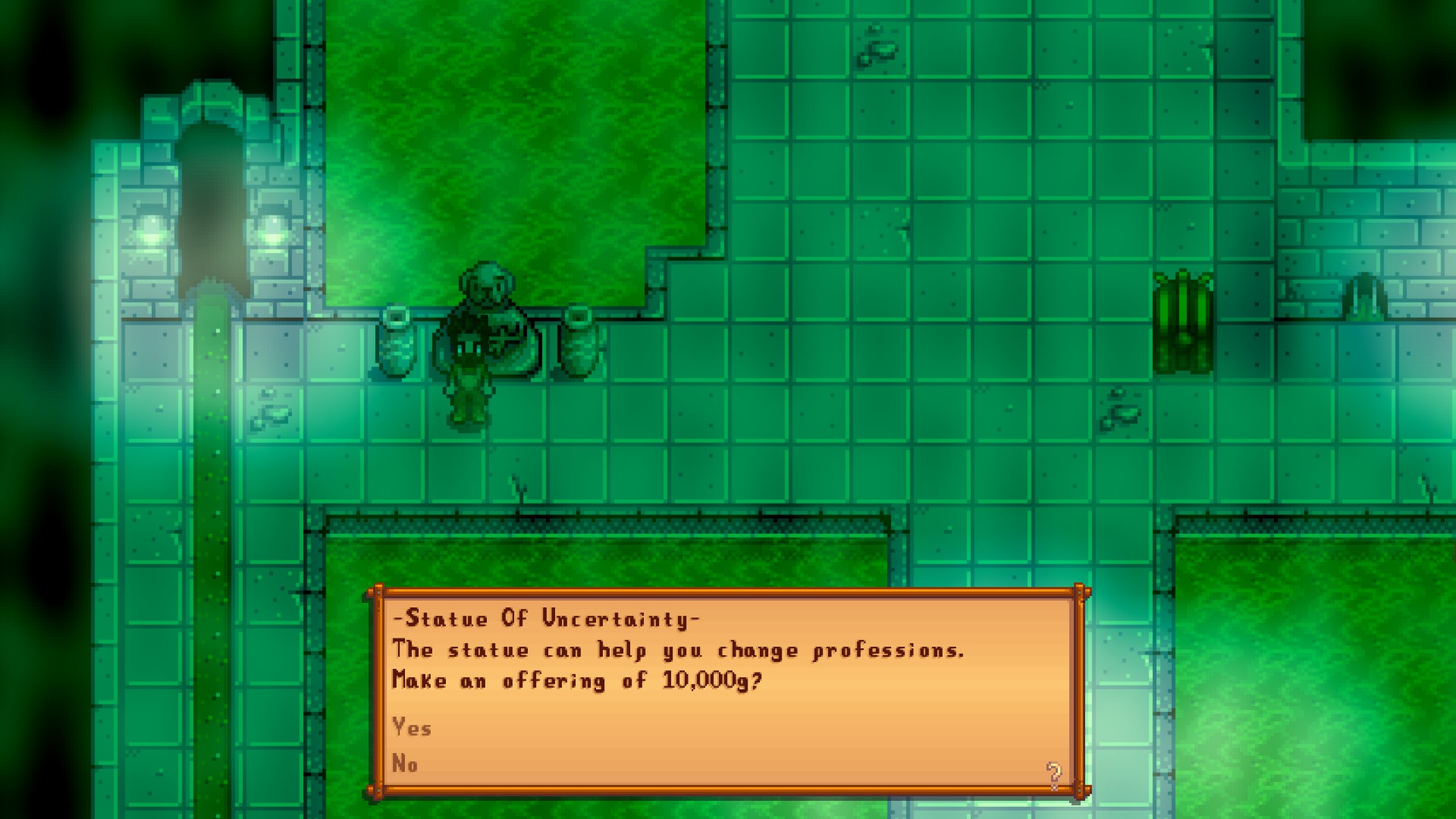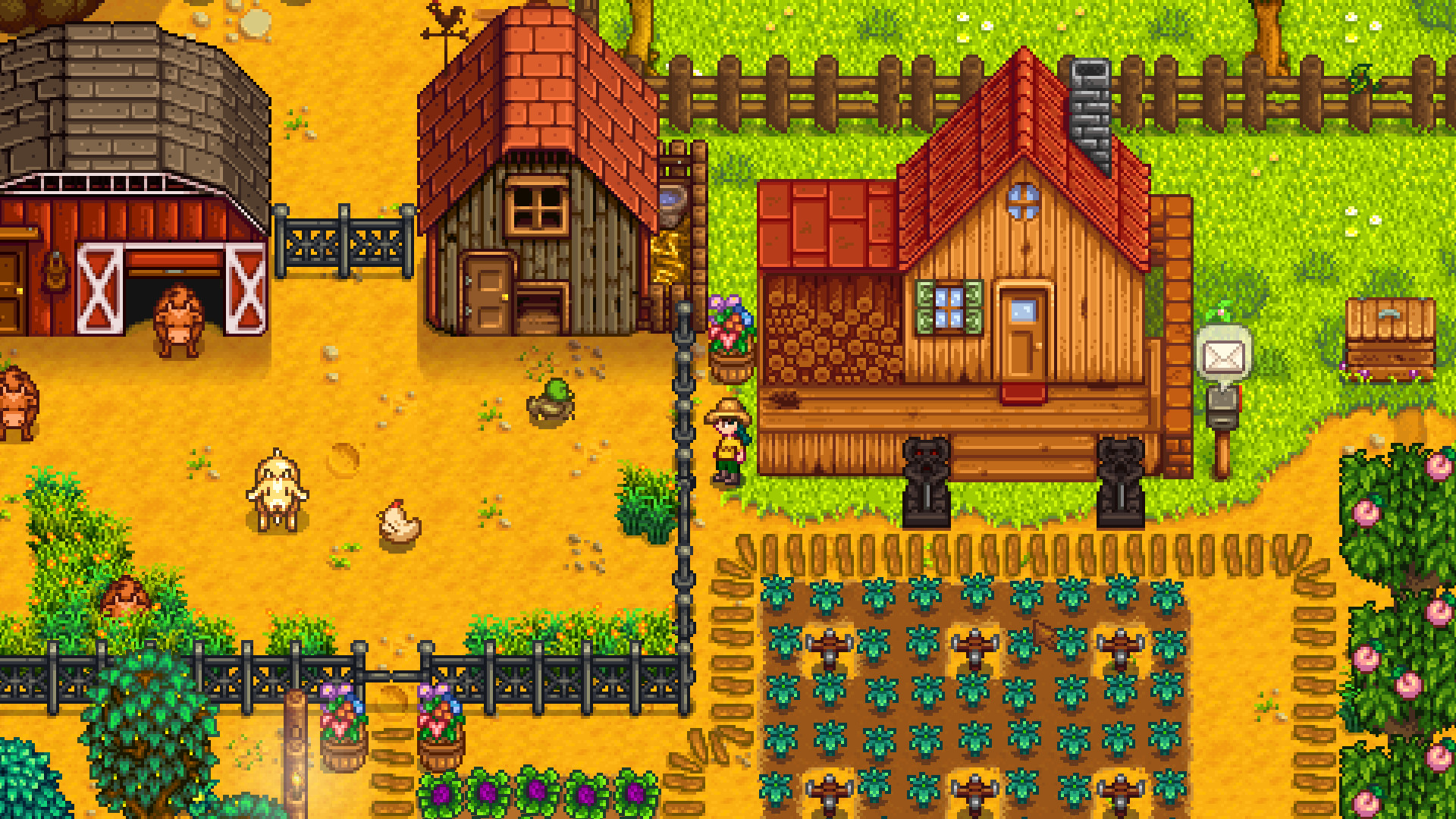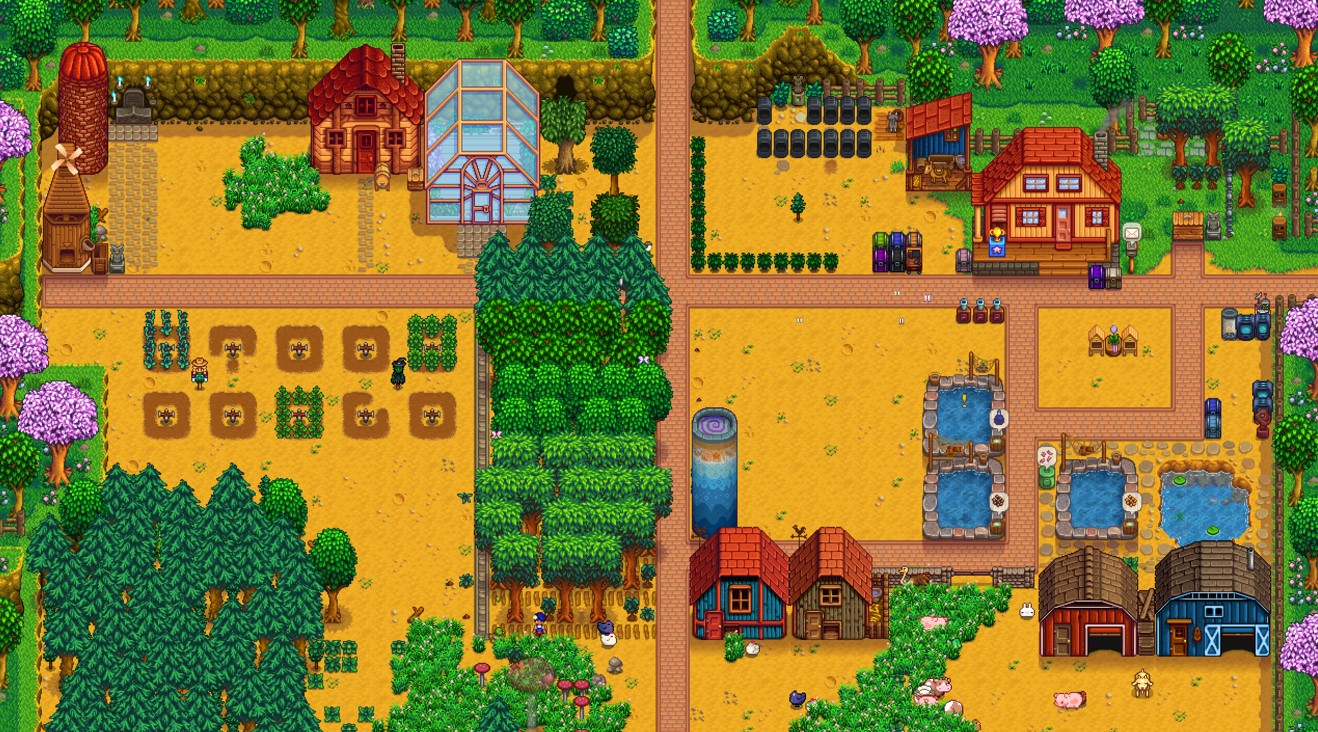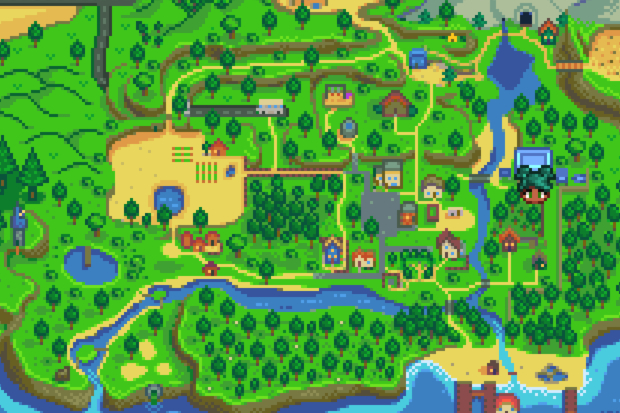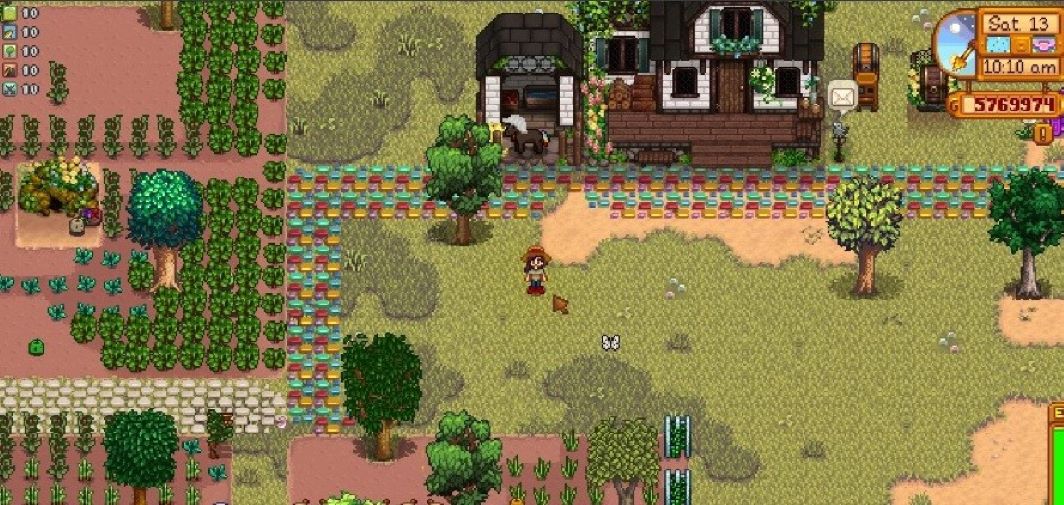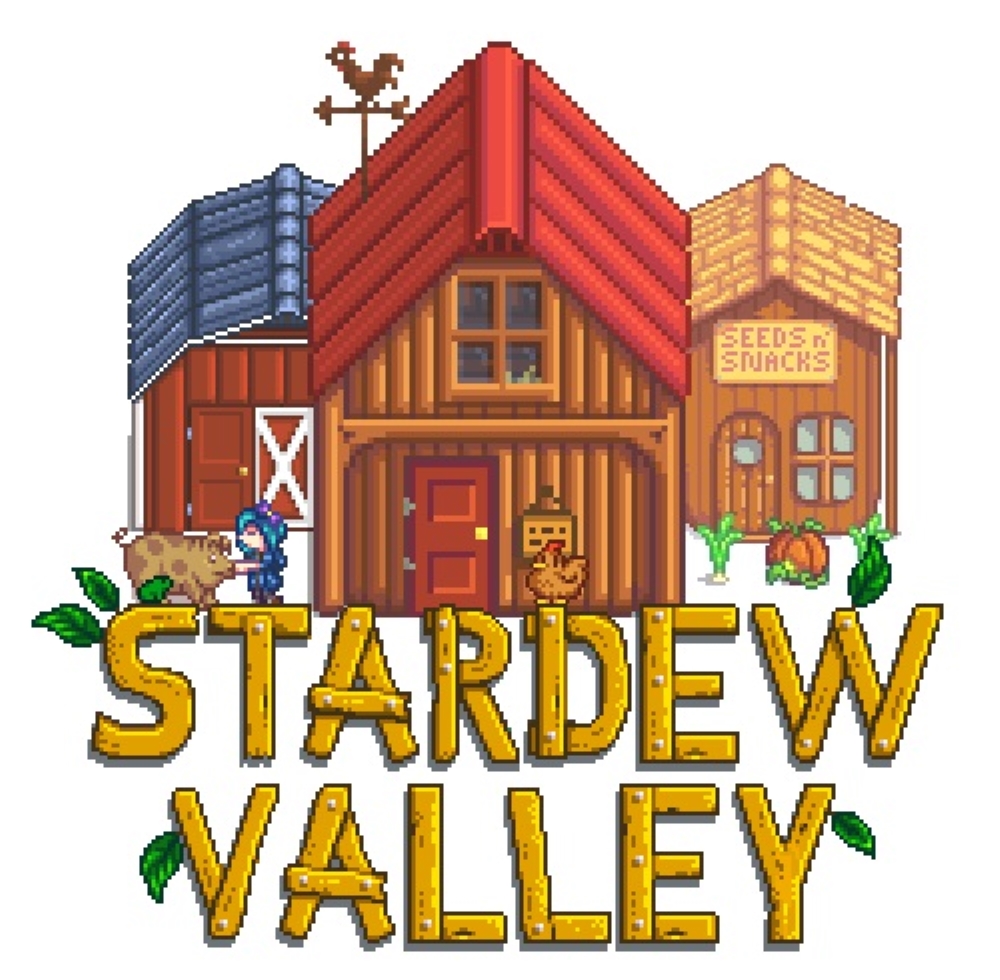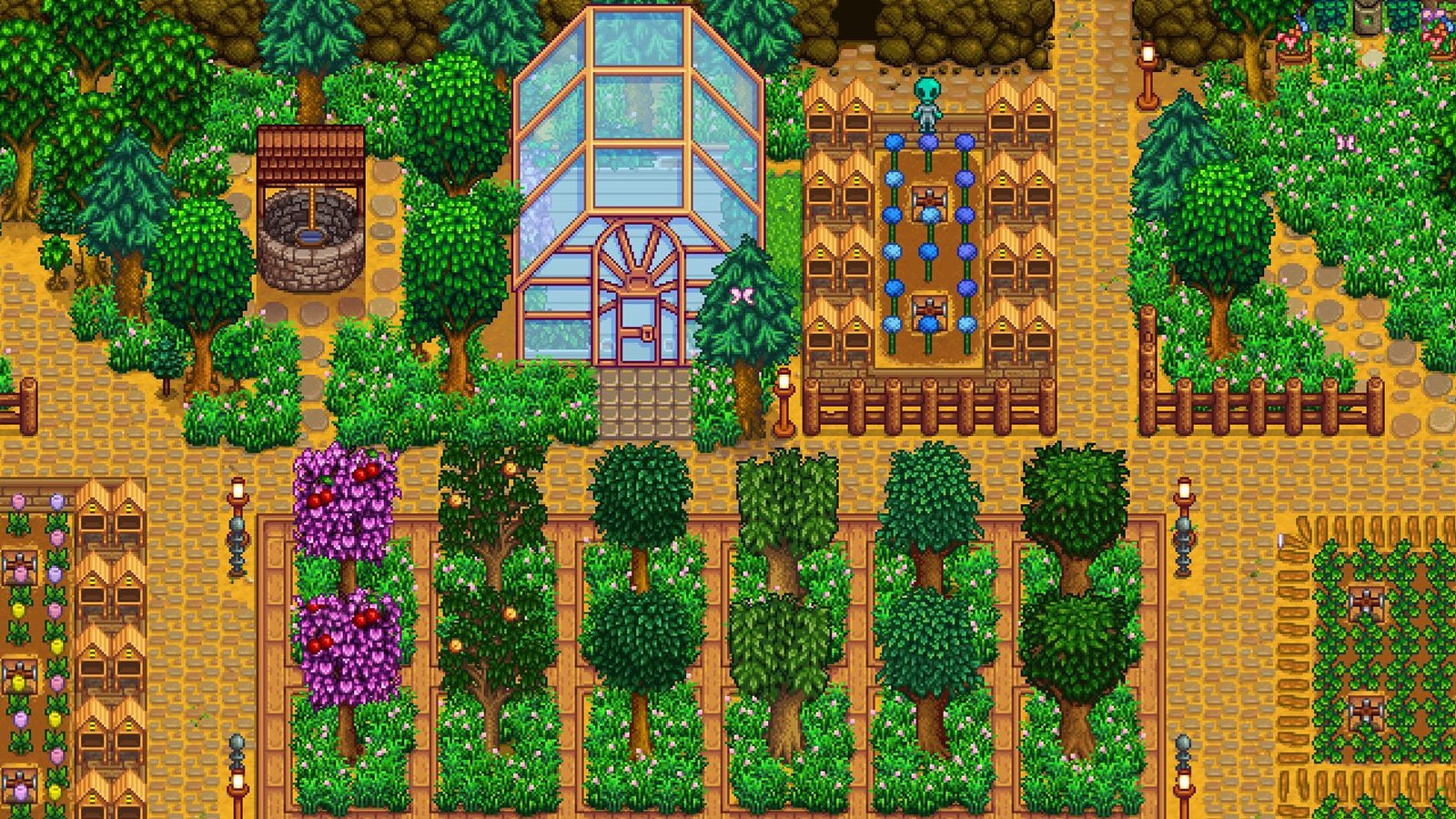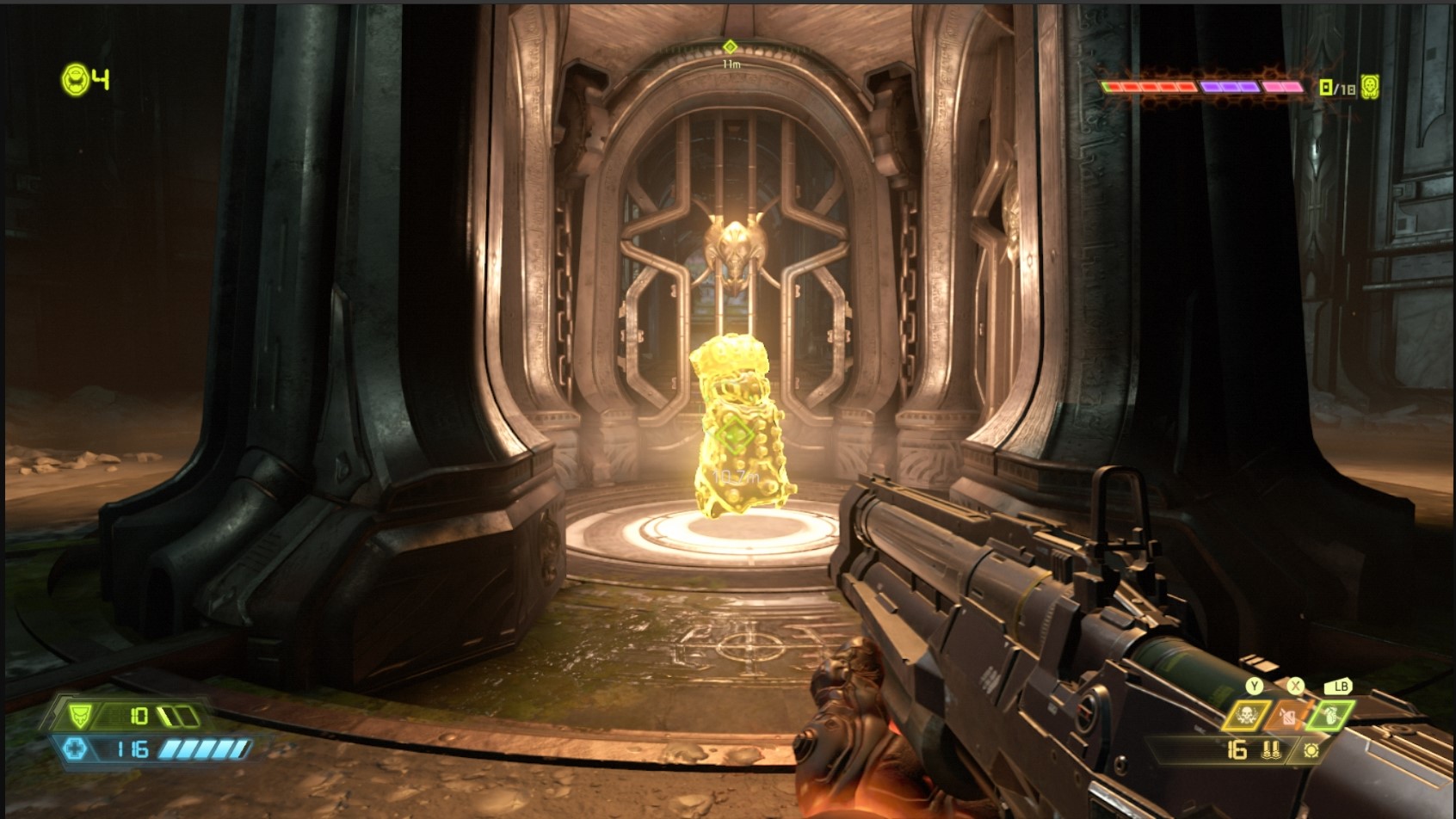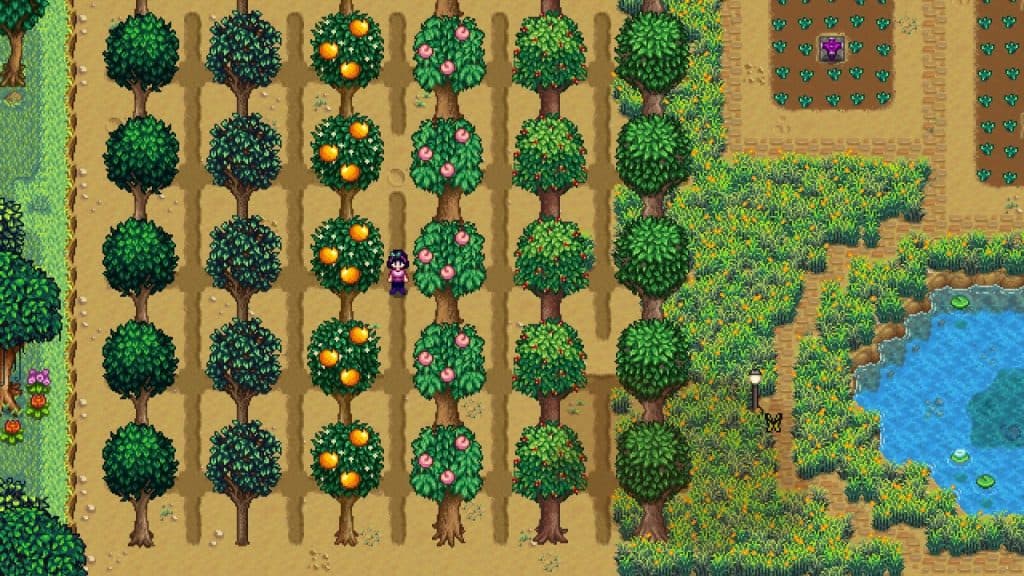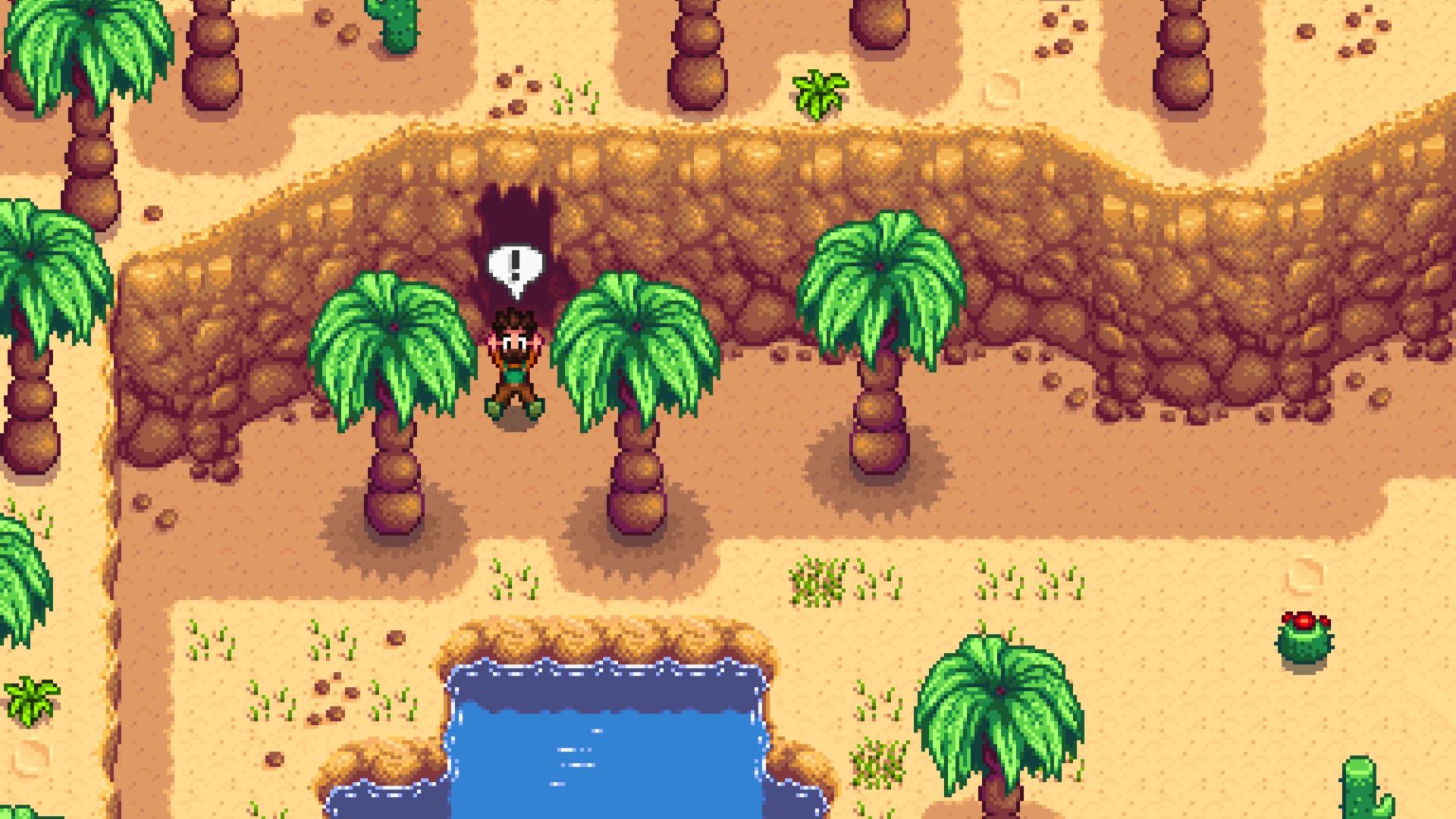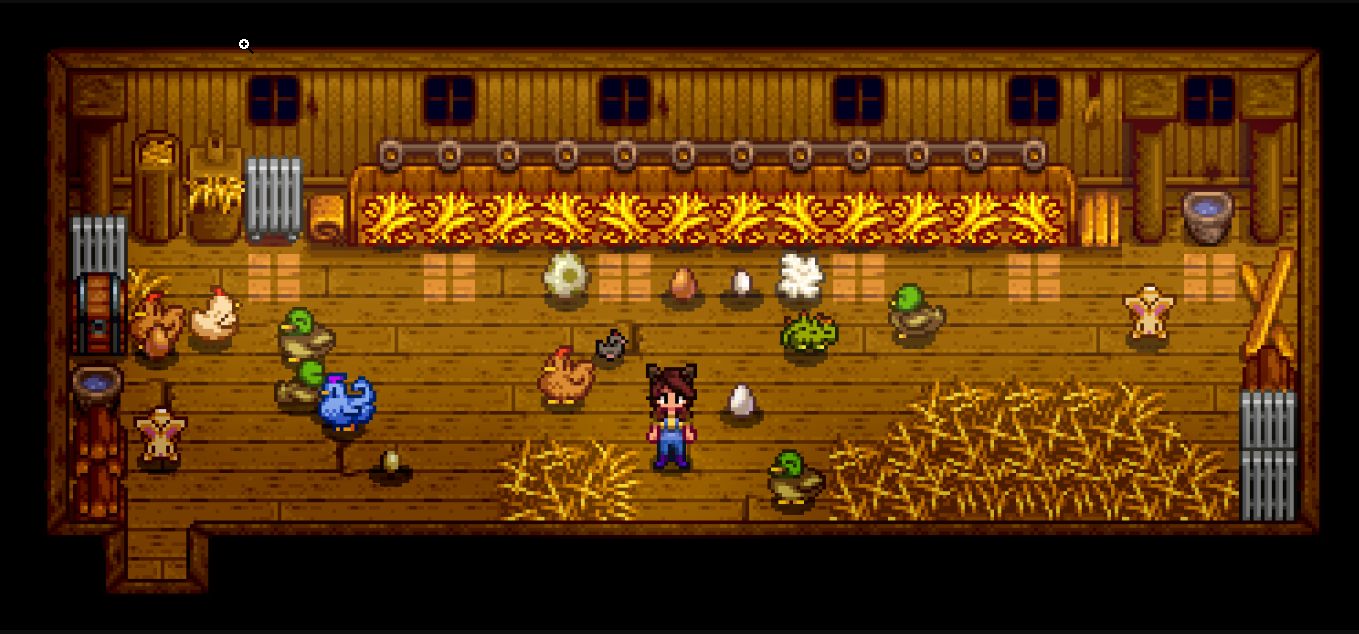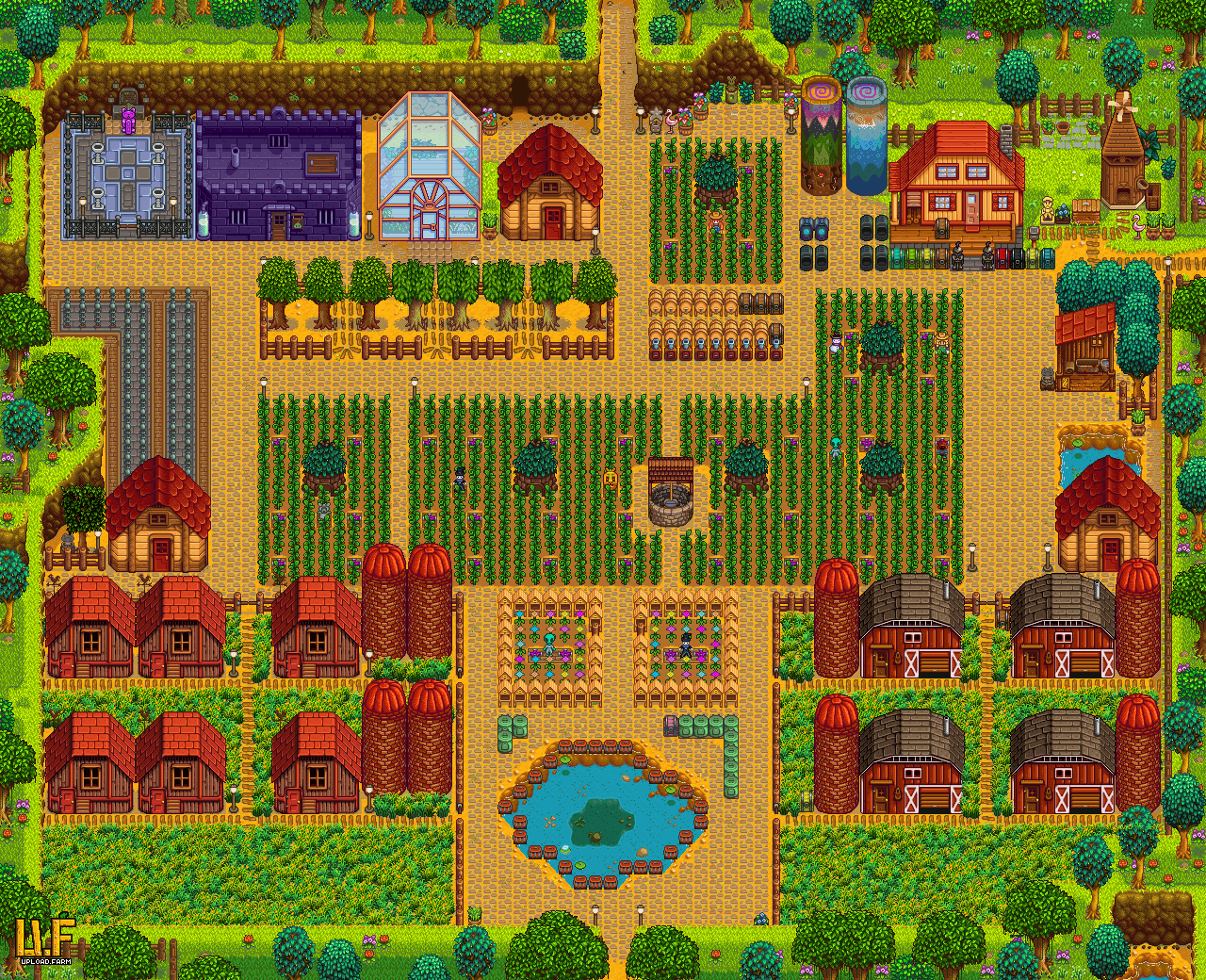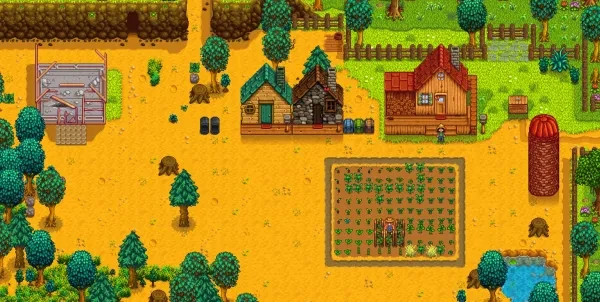
Top 25 Stardew Valley Farming Guide Tips
Get ready to set out on an exciting journey through the fascinating world of Stardew Valley! Numerous gamers have been charmed by this beloved pixelated game thanks to its lovely blend of farming, relationships, and adventure. Aspiring farmers need not be concerned—we have your back! The 25 most important farming mechanics will be thoroughly discussed in this article, with their internal functions revealed and winning tactics provided. Get ready to pick a plentiful harvest of information as we unearth the secrets of this virtual farming utopia, whether you're a budding green thumb or a seasoned veteran!
25-Tree Fertilizer
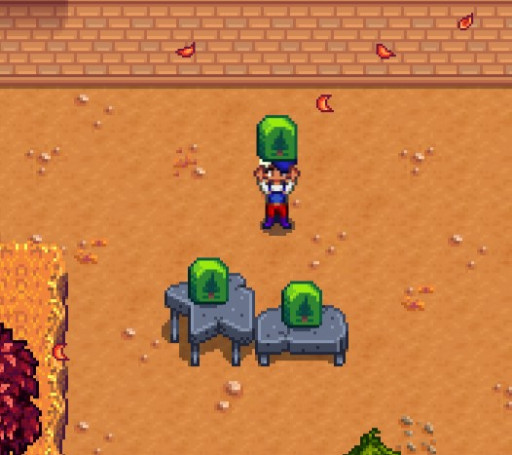
Tree Fertilizer is the sole fertilizer that may be used on trees, although it does not work on Fruit Trees or Tea Bush saplings. It functions by accelerating all wild trees' development, even throughout the winter. If you've noticed that trees don't grow over the winter but you'd like them to, use tree fertilizer!
- Source the crafting recipe after reaching Foraging Level 7
- Each fertilizer sells for 10g, which doesn’t make it profitable.
- Crafting ingredients: 5 pieces of Fiber and 5 Stone.
- 1 fertilizer is produced per craft.
This fertilizer must be applied to an already-planted tree seed or sapling, adding a red tint until the plant is completely grown. The majority of fertilized trees grow from one stage to stage 4 each night, reaching the final stage of growth after two nights. The lone exception is a Mahogany Tree, which, if fertilized, only has a 60% chance of moving on each night.
24-Basic Retaining Soil
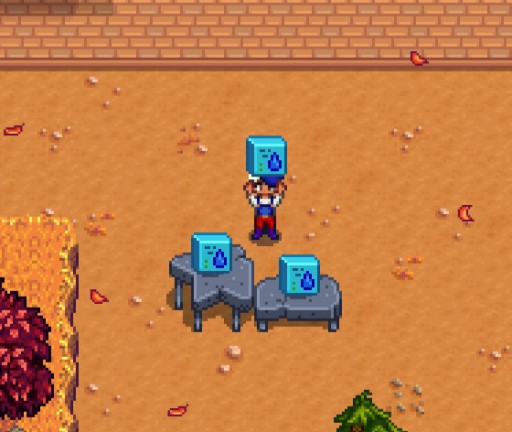
This sort of fertilizer, which falls under the first category of Retaining fertilizers, has an opportunity to keep hydrated overnight. This is rather advantageous since it can spare players from having to water all of their crops the following day and from having to put in the effort to refill the watering can. Players can either wait till they can make their own fertilizer or purchase it from Piere's.
- Starting from Spring 15 in the first year it can be purchased for 100g from Pierre’s General Store.
- Otherwise, unlock the recipe after reaching Farming Level 4.
- Each fertilizer sells for 4g
- Crafting ingredients: 2 Stone
- 1 fertilizer is produced per craft
This fertilizer can be applied before or after crops are planted, as well as at any stage of crop growth. It functions by being mixed into tilled soil. The likelihood of the soil remaining watered overnight is roughly 33%.
23-Quality Retaining Soil
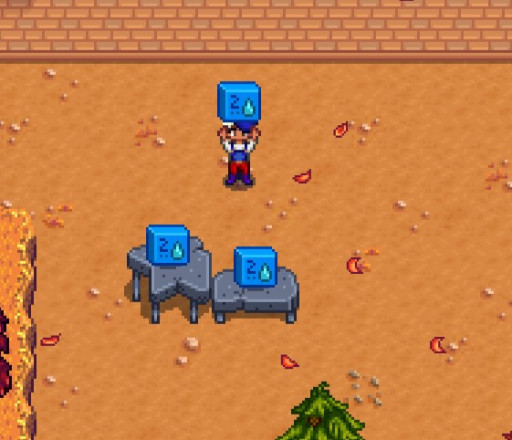
The second tier of the Retaining fertilizers, this type of fertilizer affects the crop soil with a higher chance of staying watered overnight. Players can buy the fertilizer from Piere’s, from Sandy’s Oasis Shop, or wait until they can craft it themselves. If the player has not upgraded the Farmhouse or has only upgraded it once, the player may occasionally find Quality Retaining Soil in supply crates on the Beach Farm.
- Starting from Year 2 it can be purchased for 150g from Pierre’s or for 200g from Sandy’s Oasis shop only on Saturdays.
- Players unlock the recipe after reaching Farming Level 7.
- Each fertilizer sells for 5g
- Crafting ingredients: 3 Stone and 1 Clay
- 2 fertilizers are produced per craft
This fertilizer can be applied before or after crops are planted, as well as at any stage of crop growth. It functions by being mixed into tilled soil. The likelihood of the soil remaining damp overnight is roughly 66%.
22-Deluxe Retaining Soil
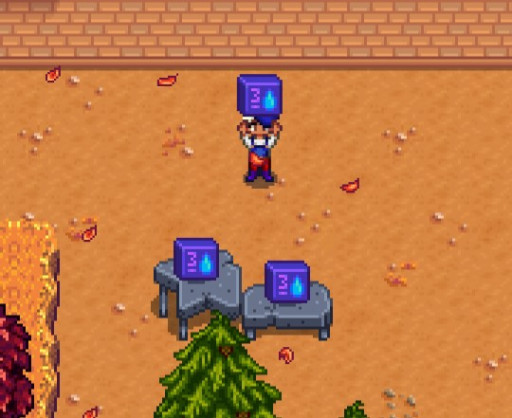
This fertilizer influences the agricultural soil with the greatest likelihood of remaining moist overnight and is the third tier of Retaining fertilizers. Players can only make fertilizer after obtaining the crafting recipe from the Island Trader. On the Beach Farm, 5 to 7 supply crates occasionally contain Quality Retaining Soil if the player has upgraded the Farmhouse at least twice.
- The recipe can be purchased for 50 Cinder Shards from the Ginger Island Trader.
- Each fertilizer sells for 30g
- Crafting ingredients: 5 Stone, 3 Fiber, and 1 Clay
- 1 fertilizer is produced per craft
This fertilizer can be applied before or after crops are planted, as well as at any stage of crop growth. The likelihood of retaining water is 100%, which indicates that after watering once, the soil will be hydrated until the crop is ready to harvest. This makes it particularly helpful when Sprinklers are not available.
21-Basic Fertilizer
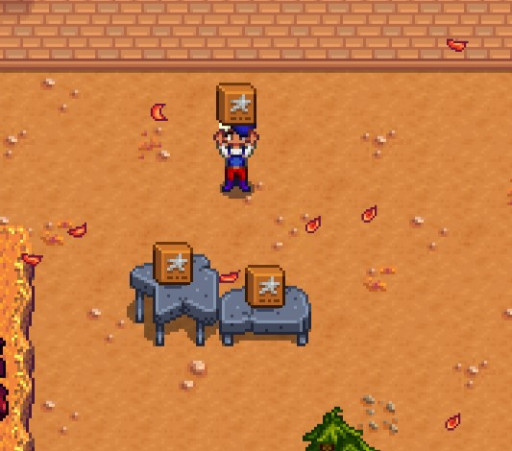
This first-tier kind of fertilizer enhances soil quality, slightly raising your chances of producing high-quality crops. This indicates that there is a possibility for crops to develop into silver- or gold-quality crops.
- Starting from Spring 15 in the first year, it can be purchased for 100g from Pierre’s General Store.
- Players unlock the recipe after reaching Farming Level 1
- Each fertilizer sells for 2g
- Crafting ingredients: 2 Sap
- 1 fertilizer is produced per craft
This fertilizer can be used before crops are planted and before they sprout, or before plant leaves develop from the seeds. Because sap may be found in abundance and is relatively simple to obtain, making fertilizer is typically less expensive than purchasing it. Any additional crops harvested after the primary harvest will be of standard quality because the fertilizer only influences the normal harvest. This means that, for crops like blueberries and cranberries, the initial crop may be of great quality while other crops may be of average grade.
20-Quality Fertilizer
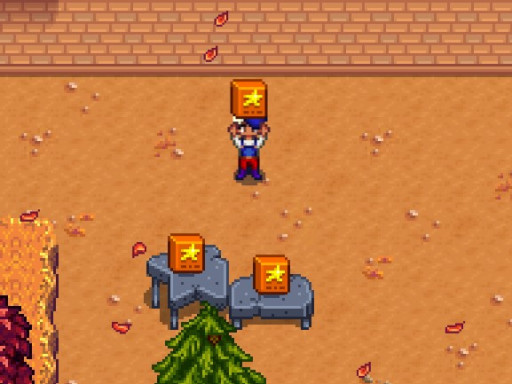
The second tier of this type of fertilizer improves soil quality, increasing your chances of growing crops of superior quality above the first tier. This suggests that there is a greater chance for crops to evolve into crops of silver- or gold quality. It is either craftable or can be made with a Bone Mill. Beginning in Year 2, it may also be bought at Pierre's General Store and in any given year, occasionally be offered by the Traveling Cart. The prize for completing the 5,000g Bundle in the Vault is 30 Quality Fertilizers.
- Starting from Year 2 it can be purchased for 150g from Pierre’s or randomly from the Traveling Cart for 100-1,000g.
- Players unlock the recipe after reaching Farming Skill Level 9
- Each fertilizer sells for 10g
- Crafting ingredients: 2 Sap and any 1 Fish
- 1 fertilizer is produced per craft
Quality Fertilizer can be used before crops are planted and must be before they sprout, or before plant leaves develop from the seeds. Any additional crops harvested after the primary harvest will be of standard quality. It is suggested that fish with a selling price of less than 150g be used to create quality fertilizer.
19-Deluxe Fertilizer
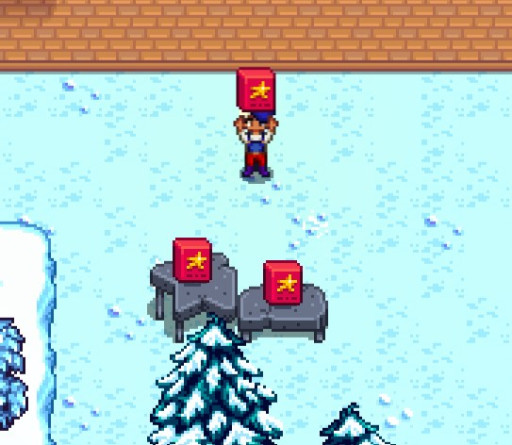
This fertilizer, which is in the third tier of high-grade fertilizers, significantly raises soil quality, enhancing your chances of producing crops of superior quality. It is only possible to obtain crops of Iridium quality through the use of Deluxe Fertilizer, and it is the only method.
- The recipe can be purchased from Qi's Walnut Room on Ginger Island for 20 Qi Gems
- Each fertilizer sells for 70g
- Crafting ingredients: 1 Iridium Bar and 40 Sap
- 5 fertilizers are produced per craft
This fertilizer can be applied to tilled soil either before or after planting or at any point throughout crop development. Any additional crops gathered will be of standard quality, with the initial crop having the highest likelihood of being silver-quality, just like the other varieties of quality fertilizer.
18-Scarecrow
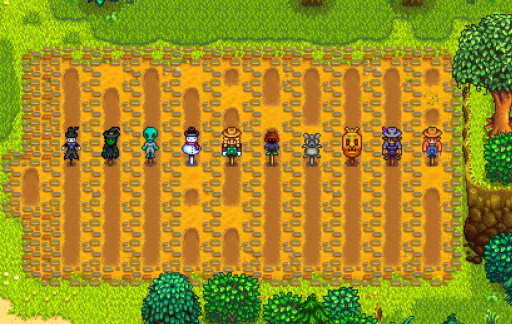
A scarecrow serves as an obstacle to crows eating crops and is a craftable item. Once a farmer has advanced to the first farming level, they can unlock one of the first crafting recipes.
- Crafting Recipe unlocks at Farming Skill Level 1
- Ingredients: 50 Wood, 1 Coal, and 20 Fiber
- They protect the surrounding circular area of 248 spaces in a 17x17 area, excluding 10 spaces in each corner.
With the exception of the Alien Scarecrow, which can be equipped with headwear, Rarecrows function in the same way as regular Scarecrows. There are eight Rarecrows in all to purchase from various locations.
- Rarecrow 1–Purchase at the Stardew Valley Fair for 800 tokens.
- Rarecrow 2–Purchase at the Spirit's Eve festival for 5,000g.
- Rarecrow 3–Purchase at the Casino for QiCoin 10,000.
- Rarecrow 4–Purchase at the Traveling Cart randomly during fall or winter for 4,000g,
- or purchase at the Festival of Ice for 5,000g.
- Rarecrow 5–Purchase at the Flower Dance for 2,500g.
- Rarecrow 6–Purchase from the Dwarf for 2,500g.
- Rarecrow 7–Donate 20 Artifacts (not counting Minerals) to the Museum. Can be purchased from the Night Market once the first one is earned.
- Rarecrow 8–Donate 40 items to the Museum. Can be purchased from the Night Market once the first one is earned.
Soon after obtaining all 8 Rarecrows, a letter containing the instructions for making a Deluxe Scarecrow will appear. This additional craftable scarecrow has an impact on 888 tiles overall and has a radius that is double that of a typical scarecrow.
- Recipe Source: Letter after collecting all Rarecrows
- Ingredients: 50 Wood, 1 Iridium Ore, 40 Fiber
A message indicating how many crows a scarecrow has scared away is displayed when it is interacted with; the message is reset when the scarecrow is picked up. Crows do not attack crops grown from wild seeds, thus scarecrows are not necessary to protect them. Ginger Island doesn't have any crows, so none should be added to the farm there. Scarecrows cannot be sold.
17-Speed-Gro
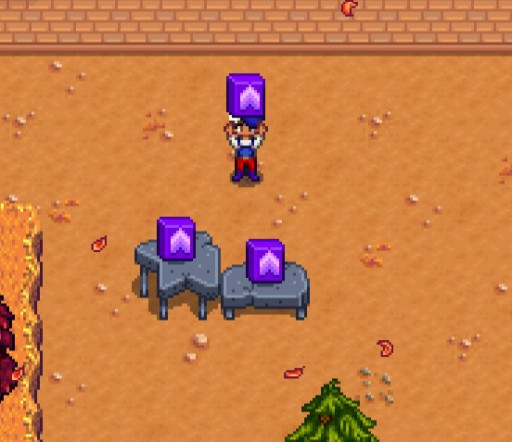
This sort of fertilizer's top tier encourages crop production and raises the growth rate by at least 10%. The rate increases to 20% for the profession of agriculturist. It can be created with a bone mill, made at home, or purchased at Pierre's General Store. 20 Speed-Gro Fertilizers are the reward for finishing the Spring Crops Bundle in the Pantry.
- Starting from Spring 15 in the first year, it can be purchased for 100g from Pierre’s General Store
- Players unlock the recipe after reaching Farming Skill Level 3
- Each fertilizer sells for 20g
- Crafting ingredients: 1 Pine Tar and 1 Clam
- 5 fertilizers are produced per craft
Speed-Gro can be applied to tilled soil either before or after seeding or at any point throughout crop development. Keep in mind that for multi-harvest crops, the rate of growth does not shorten the time between harvests. The cost of building Speed-Gro is equal to the selling price of its main ingredients, hence making it always less expensive than buying it.
16-Deluxe Speed-Gro
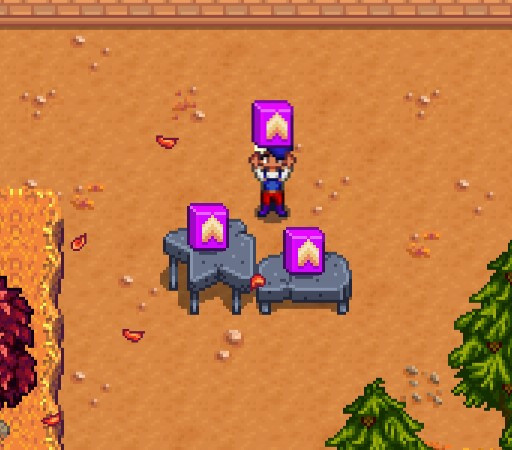
This fertilizer's second tier accelerates growth by at least 25%. In the case of agriculturalists, the rate rises to 35%. It can be manufactured at home, using a bone mill, or bought from Pierre's General Store. The Feast of the Winter Star also offers the opportunity to receive 10 Deluxe Speed-Gro as a gift.
- Starting from Year 2 it can be purchased for 150g from Pierre’s or from Sandy’s Oasis Shop for 80g on Thursdays.
- Players unlock the recipe after reaching Farming Skill Level 8
- Each fertilizer sells for 40g
- Crafting ingredients: 1 Oak Resin and 1 Coral
- 5 fertilizers are produced per craft
Just like the previous tier, speed-Gro can be applied to tilled soil either before or after seeding or at any point throughout crop development. The rate of growth does not shorten the time between multi-harvest crops. The cost of crafting Deluxe Speed-Gro is cheaper than the selling price of its main ingredients, hence making it always less expensive than buying it.
15-Hyper Speed-Gro
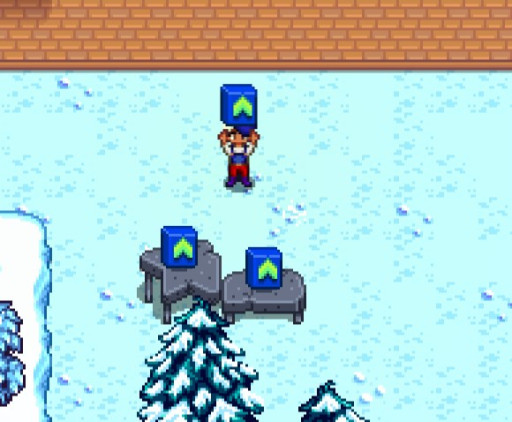
The third tier of this fertilizer has the highest guaranteed to increase growth rate by at least 33%. In the case of the agriculturalist profession, the rate rises to 43%.
- The recipe can be purchased from Qi's Walnut Room on Ginger Island for 30 Qi Gems
- Each fertilizer sells for 70g
- 1 Radioactive Ore, 3 Bone Fragments, and 1 Solar Essence
- 1 fertilizer is produced per craft
At any point throughout the growth of a crop, Hyper Speed-Gro can be applied to tilled soil before or after seeding. The duration between multiple harvests of a crop is not shortened by the rate of growth.
14-Tappers
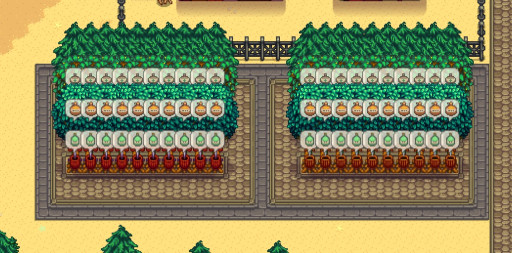
The Tapper is a kind of crafted refining machine that can be mounted on a tree to yield sap, pine tar, oak resin, or maple syrup. To grow various mushrooms, tappers can also be placed on a mushroom tree.
- Recipe Source: Unlock after reaching Foraging Skill Level 3
- Ingredients: 40 Wood and 2 Copper Bars
Details about the products Tappers produce:
- Maple Tree produces a sweet Maple Syrup and it takes 9 nights to make. Its selling price is 200g and it can be consumed, providing +50 Energy and +22 Health.
- Oak Resin, a sticky, fragrant substance derived from oak sap is produced from the Oak Tree. It takes 7 nights to produce one resin and sells for 150g. It’s not edible but is used as an ingredient in crafting recipes.
- A pungent substance derived from the sap of the Pine Tree, Pine Tar is produced after 5 nights. Selling for 100g, just like Oak Resin it is inedible and is used in crafting recipes.
- Sap is the fluid obtained from chopping down all trees but using the tapper with the Mahogany Tree produces sap. It only takes one night to produce one sap and it sells for 2g. Sap can be eaten but it’s poisonous.
- The Mushroom Tree produces the Common Mushroom, the Red Mushroom, and the Purple Mushroom.
The Heavy Tapper is a crafted refining machine that works at twice the production rate of a regular Tapper. The recipe can be purchased in Mr. Qi's Secret Walnut Room on Ginger Island. Just like the regular Tappers, it can be placed on a tree to produce Maple Syrup, Oak Resin, Pine Tar, or Sap. It can also be placed on a Mushroom Tree to produce different mushrooms, but the production rate is not increased compared to a regular Tapper.
- Recipe Source: Qi's Walnut Room for 20 Qi Gems
- Ingredients: 30 Hardwood, 1 Radioactive Bar
By giving the two types of Tappers a single strike with an axe or pickaxe, they can be unhooked from a tree and reused. The Tapper and its contents are destroyed if it is on a tree and is hit by lightning or an explosive bomb. Tappers installed on Maple, Oak, Pine, or Mahogany trees continue to produce over the winter; but, because Mushroom trees become stumps during the winter, these tappers have no effect.
13-Garden Pot
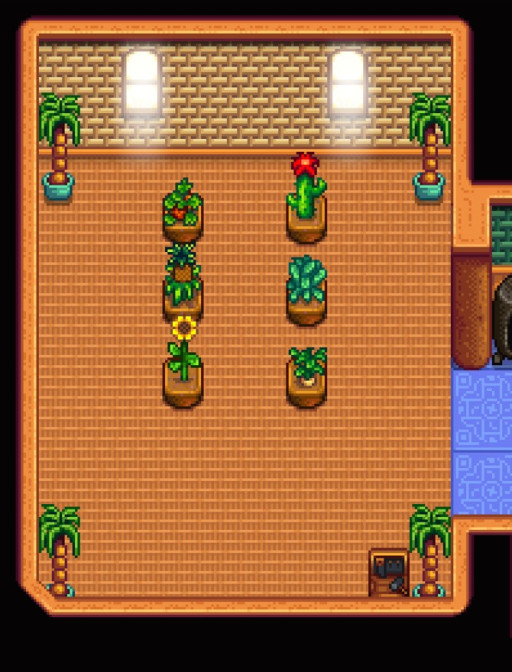
A crafted object called a Garden Pot enables plants to be cultivated indoors. Crops can also be raised outside on The Farm or the Ginger Island Farm using it. With the exception of the outdoor areas of The Farm, where they must be from the current season, the crops can be from any season.
Crops can be grown in garden pots in any location that is not impacted by the weather. All agricultural structures, The Cave, The Tunnel, The Sewers, the Mutant Bug Lair, the Witch's Swamp, the entrances to The Mines and Skull Cavern, as well as the residences of the villagers, are among the areas that are available.
- Recipe Source: After the Greenhouse is completed there will be a cutscene with Evelyn who will then give players a garden pot as well as the recipe.
- Crafting Ingredients: 1 Clay, 10 Stone, 1 Refined Quartz
The Evelyn cutscene triggers after 3 days of the Greenhouse completion via completing the Bundles when the player exits the Farmhouse between 6 am and 11:30 am on a Sunny day during any season. However, there is no 3-day delay in triggering the event when repairing the greenhouse via the Joja Community Development Form.
Some things to note about Garden Pots:
- Flower honey won't be produced if flowers are planted in pots and placed close to bee houses.
- The garden pots have the advantage of not being attacked by crows and not requiring a hoe to be used before planting.
- The same limitations and advantages apply to the use of fertilizers in garden pots as they do in tilled soil. Crops need daily watering because sprinklers cannot be used with the pots. Utilizing Retaining Soil will help players water their plants less frequently.
12-Farm Computer
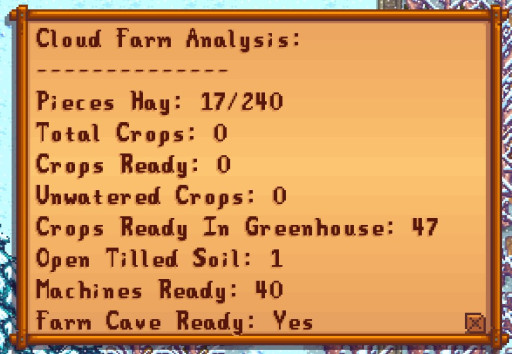
The Farm Computer is a craftable piece of machinery that may be used to interact and display data about the farm. After fulfilling either the "Aquatic Overpopulation" or the "Biome Balance" special orders for Demetrius, the player is given the recipe.
- Recipe Source: A Special Order from Demetrius
- Crafting Ingredients: 1 Dwarf Gadget, 1 Battery Pack, 10 Refined Quartz
The state of the farm computer shows data such as how much hay is present in the soil, how many crops are planted, ready for harvest, and whether any crops need to be watered. It even indicates whether the farm has any forgeable objects, and if Fruit Bats are chosen for the Farm Cave, it is useful to know whether there is fruit there. Unfortunately, even if placed there, a Farm Computer will never show data about the farm on Ginger Island.
Even if forage items like truffles are present on your farm, "Forage Items" will only be displayed if used on the Forest or Beach farms. Seasonal Wild Seed crops are displayed under "Crops".
11-Crystalarium
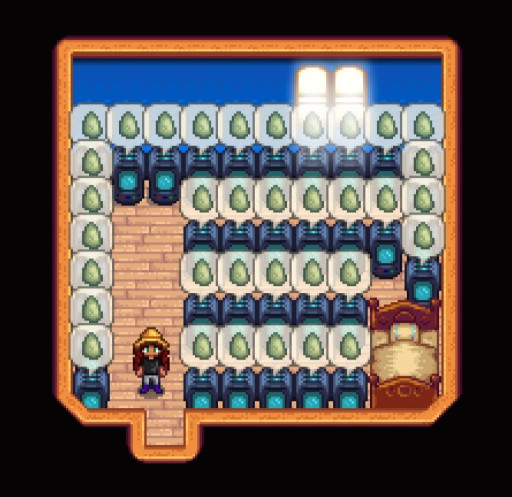
The Lost Book Technology Report explains how a Crystalarium works. It is claimed to be a piece of machinery that can create crystals out of nothing, giving its owners access to an unending supply of priceless stones! Any inserted Gem, Foraged Mineral, or Geode Mineral will be duplicated countless times by this refining apparatus. It can be made or discovered in a treasure room in the Skull Cavern. The electric and magnetic fields (EMF) from the shard interact negatively with the crystalarium, which is unfortunate, therefore crystalariums are unable to duplicate prismatic shards. The prize for giving 50 Minerals to the Museum is one Crystalarium. The 25,000g Bundle in the Vault can be completed for one Crystalarium as well.
- Recipe Source: Unlock after reaching Mining Skill Level 9
- Crafting Ingredients: 99 Stone, 5 Gold Bars, 2 Iridium Bars, and 1 Battery Pack
On Sundays, it is advised to trade for staircases with the Desert Trader by replicating jade in the Crystalarium. The stairs can then be used or inserted into a Deconstructor to generate 99 stones, eliminating many hours of stone harvesting.
A gem or mineral can be removed from the Crystalarium at any moment by prying it open with a tool after it has been set up. In order to recover the seeded gem before replacing the gem in a Crystalarium, the Crystalarium must first be broken; otherwise, the original gem will be lost and replaced with the new gem. After that, set it down once more and insert the fresh jewel.
10-Lightning Rod
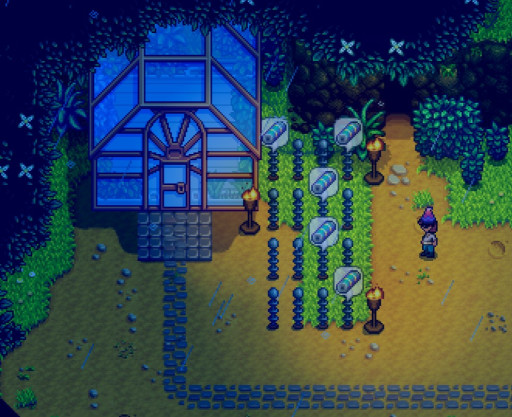
Another piece of refinement equipment, the Lightning Rod, produces a Battery Pack the day after being struck by lightning during a storm. Because loose lightning can strike fruit trees and damage crops, trees, and farm debris, it also serves to defend the farm. The location of a rod on a farm has little influence on its likelihood of deflecting a lightning strike because they do not guard a specific area. A Lightning Rod has a very strong chance of catching a lightning strike as long as it isn't currently processing one. A lightning rod is the reward for completing the 10,000 Bundle in the Vault.
- Recipe Source: Unlock after reaching Foraging Skill Level 6
- Ingredients: 1 Iron Bar, 1 Refined Quartz, and 5 Bat Wings
It can be used during Spring, Summer, and Fall Storms, but not in winter as there are no storms during that season. Storms also never occur on Ginger Island so don’t bother with placing any lighting rods there.
The longer the player is awake during a stormy day, the more lightning will strike. This can mean that more lightning rods can be used to produce more Battery Packs. Just know that it’s not necessary for the player to be on the farm when the lightning strike happens, so they can continue about their day doing their various tasks. Lightning strikes occur at random throughout the day, and their frequency rises with increasing Daily Luck.
9-Sprinklers

The basic Sprinkler is a crafted item that waters 4 tiles in a plus sign area every morning. All sprinklers can only water tilled tiles. The basic Sprinkler is another crafting recipe unlocked early in the game.
- Recipe Source: Unlock after reaching Farming Skill Level 2
- Sell Price: 100g
- Ingredients: 1 Copper Bar, 1 Iron Bar
The Quality Sprinkler is a crafted item that waters the 8 adjacent tiles in a 3x3 area every morning. It is a reward for completing the Summer Crops Bundle in the Pantry and the Remixed Garden Bundle in the Pantry. It can also randomly rotate into stock at the Traveling Cart. Four Quality Sprinklers may occasionally be found in treasure rooms in the Skull Cavern.
- Recipe Source: Unlock after reaching Farming Skill Level 6
- Randomly purchase from the Traveling Cart for for 1,350–2,250g.
- Sell Price 450g
- Crafting Ingredients: 1 Iron Bar, 1 Gold Bar, 1 Refined Quartz
The Iridium Sprinkler is a crafted item that waters the 24 adjacent tiles in a 5x5 area every morning. One to two Iridium Sprinklers may occasionally be found in treasure rooms in the Skull Cavern and it can be purchased from Krobus.
- Purchase one Iridium sprinkler from Krobus for 10,000g every Friday
- Recipe Source: Unlock after reaching Farming Skill Level 9
- Sell Price 1,000g
- Crafting Ingredients: 1 Gold Bar, 1 Iridium Bar, 1 Battery Pack
It’s important to note that Sprinklers cannot be used to water Garden Pots or the pet's water bowl. Sprinklers cannot be placed on sand, so keep that in mind for players who choose the Beach Farm.
Upgrades can be attached onto a placed sprinkler. It’s okay to pick up the sprinkler as while it will remove the upgrade, it is done without destroying it. Only one upgrade can be used at a time on a single sprinkler.
- There is the Pressure Nozzle upgrade. Placing this nozzle on a sprinkler will increase its watering range. 4 nozzles can be bought for 20 Qi Gems or one may occasionally be found in the Mines as a special monster drop during a Qi quest.
- Then is the Enricher upgrade. Placing an Enricher on a sprinkler will load it with fertilizer to automatically apply it when planting seeds nearby. 4 nozzles can also be purchased for 20 Qi Gems or drop from a special monster during a Qi quest.
8-Seed maker
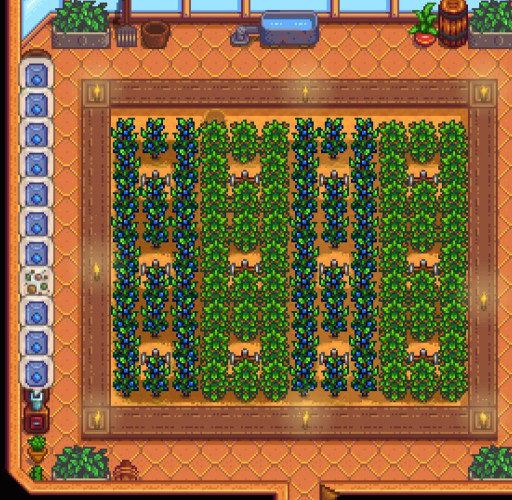
A piece of refining equipment called the Seed Maker creates seeds from a crop that has been harvested or from one of four foraged foods: wild horseradish, spice berries, common mushrooms, or winter roots. Processing seeds takes 20 game minutes.
One Seed Maker can occasionally be discovered in a treasure room in the Skull Cavern. It is the reward for completing the Dye Bundle on the Bulletin Board.
- Recipe Source: Unlock after reaching Farming Skill Level 9
- Crafting Ingredients: 25 Wood, 1 Gold Bar, 10 Coal
The Seed Maker has a slight chance of producing 1 package of Ancient Seeds, 1-4 Mixed Seeds, or a 97.51% chance of producing 1-3 seeds of the same variety as the input crop. An average of nearly half of the harvests would need to be given up in order to acquire new seeds for the following growing cycle. Aside from the crops mentioned above, any item marked as "Forage" in the game, such as foraged flowers, berries, coconuts, or fruit from fruit trees, does not yield seeds when used in the Seed Maker.
7-Fruit Trees
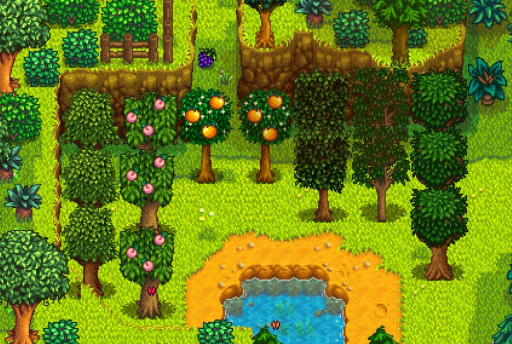
Unlike the other plantable trees, Fruit Trees require 28 days to mature, after which they produce one fruit per day when in season. Fruit can accumulate up to three days before harvesting. Fruit trees do not need to be watered, and will not die in the winter. The saplings will grow during any season, allowing players to plant and prepare for upcoming seasons to bear fruit.
A Fruit Tree is planted directly into untilled ground. Fruit trees can grow in the Greenhouse, in the center soil or around the border, which is perfect for having fruit all year round. Fruit trees planted in the greenhouse or on Ginger Island bear fruit every day after maturity, and will not change color according to the season. Just like regular trees, fruit trees can be chopped down, and yield normal wood.
If purchased from Pierre's General Store, a full set of all six fruit tree saplings costs a total of 25,400g.
Spring
- Apricot Tree–Purchase from Pierre for 2,000g or from the Traveling Cart for 1,500–2,500g
- Cherry Tree–Purchase from Pierre for 3,400g, or from the Traveling Cart for 2,550–4,250g
Summer
- Banana Tree–Purchase from the Island Trader for 5 Dragon Teeth
- Mango Tree–Purchase from the Island trader for 75 Mussels
- Orange Tree–Purchase from Pierre for 4,000g or from the Traveling Cart for 3,000–5,000g
- Peach Tree–Purchase from Pierre for 6,000g or from the Traveling Cart for 4,500–7,500g
Fall
- Apple Tree–Purchase from Pierre for 4,000g or from the Traveling Cart for 3,000–5,000g
- Pomegranate Tree–Purchase from Pierre for 6,000g or from the Traveling Cart for 4,500–7,500g
6-Scythe
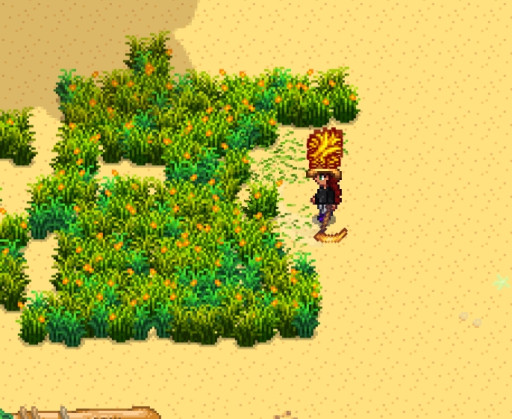
The Scythe is a starter tool that cuts grass and turns it into Hay with a Silo on the farm. It works great to remove tiny wild tree saplings and wild fiber plants growing across the farm and other areas.
- It inflicts 1-3 damage
- Critical Strike Chance: 0.02
The Golden Scythe is a tool obtained at the end of the single-floor Quarry Mine from the statue of the Grim Reaper. If this scythe is lost, it cannot be replaced.
The Golden Scythe has the following benefits:
- Its radius is larger than the standard Scythe and it is more likely to cut all grass in its radius.
- 75% chance per swipe to harvest hay from grass, up from 50%. It inflicts 13 damage.
5-Hoes
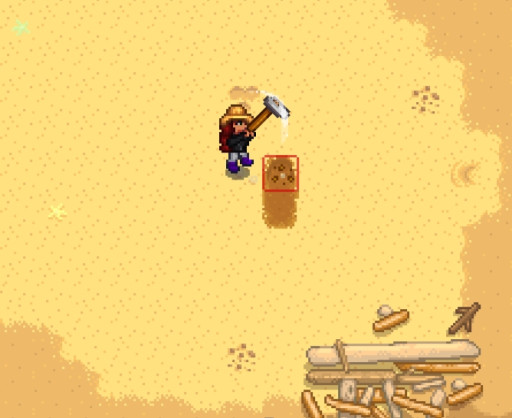
The Hoe is a tool obtained at the beginning of the game. It can also be used to till sand in The Mines, on The Beach, in The Desert, as well as other regions in Stardew Valley that have exposed dirt. It is mostly used to till the soil for farming and dig up Artifact Spots. Tilling sand in the Mines may yield Artifacts, Cave Carrots, and other items. Above ground, tilling soil may yield Clay, metal ores, or Mixed Seeds. In Winter, many more areas can be tilled. These may additionally yield Snow Yams or Winter Roots.
The Hoe may be upgraded at the Blacksmith. The cost and resource requirements for each upgrade are shown in the table below. To till more than one tile at a time, hold left-click to "power-up" an upgraded Hoe, then release it to till an area.
- Copper Hoe–Upgrade with 5 Copper Bars for the cost of2,000gIncreases maximum area of effect to 3 tiles in a straight line.
- Steel Hoe-Upgrade with 5 Iron Bars for the cost of 5,000g. It increases the maximum area of effect to 5 tiles in a straight line.
- Gold Hoe–Upgrade with 5 Gold Bars for the cost of 10,000g. It increases the maximum area of effect to a 3x3 area (9 corresponding tiles).
- Iridium Hoe–Upgrade with 5 Iridium bars for the cost of 25,000g. It increases the maximum area of effect to a 6x3 area (18 corresponding tiles).
4-Watering Cans
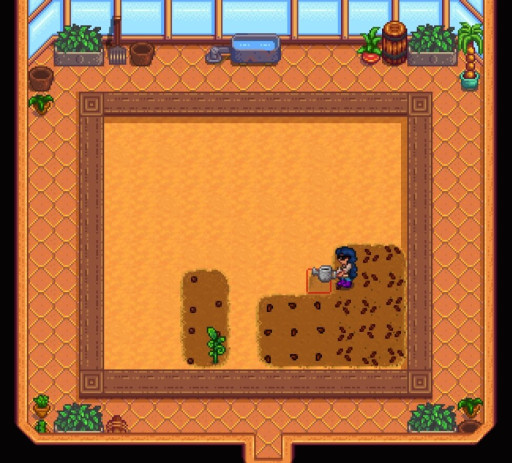
The Watering Can is a tool obtained at the beginning of the game that is used to water Crops. It You can irrigate Crops with the Watering Can, a starter item you get early on in the game. Any water source, including the kitchen sink in a renovated farmhouse, can be used to refill it. Up until it is fully matured, every crop needs to be watered every day. Any day that a young crop is left without water, it doesn't die, but it also doesn't grow. Additionally, mature plants that yield many harvests need to be watered every day. On days when it rains, crops that were planted outside do not need to be watered. No of the weather, crops cultivated indoors in greenhouses and garden pots need to be watered because rain does not cover them.
The Blacksmith offers upgrades for the Watering Can. The watering area grows in increments of three squares, five squares, a 3 by 3 box, and finally a 3 by 6 box. In the winter, when it's not necessary, it's simpler to improve the watering can.
When upgrading the watering can in the middle of the season, it is a good idea to first watch the weather report on TV and upgrade it when a wet or stormy forecast is shown for the following day. Give Clint the watering can the same day after first watering all the crops. The rain the following day will irrigate all the crops. The following day, the watering can will be prepared..
The watering can should also be upgraded on the 27th day of any season because most crops don't require watering on the 28th because they will wither away when the new season arrives. On the first day of the upcoming season, the watering can will be ready.
The Starter Watering Can has a total water capacity of 40 charges before it has to be refilled.
Copper Watering Can can be upgraded using 5 Copper Bars for the cost of 2,000g. This increases the apacity to 55 charges and the maximum area of effect to 3 tiles in a straight line.
Steel Watering Can can be upgraded using 5 Iron Bars for the cost of 5,000g. This increases the capacity to 70 charges and the maximum area of effect to 5 tiles in a straight line.
Gold Watering Can can be upgraded using 5 Gold Bars for the cost of 10,000g. This increases the capacity to 85 charges and the maximum area of effect to a 3x3 area (9 corresponding tiles).
Iridium Watering Can can be upgraded using 5 Iridium Bars for the cost of 25,000g. It increases the capacity to 100 charges and the maximum area of effect to a 6x3 area (18 corresponding tiles).
3-Fences
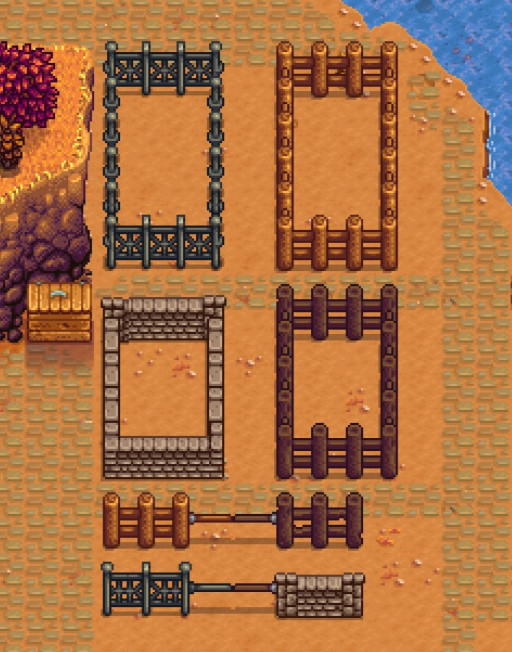
Fences section off areas and block players, farm animals, and the spread of grass. There are different fence types that only differ in appearance and durability. All fences will decay over time and will disappear entirely if left in a damaged state for too long. A shortcut to replacing a damaged fence is to "use" the broken fence while a new fence is equipped in inventory. If married, sometimes your spouse may fix some broken-state fences daily before you leave the house. Having a Gold Clock on the farm will prevent fences from decaying.
Gates are part of Fences and can be used to pass through them, and closed to keep livestock and pets contained. Torches can be placed on a fence.
- Allows you to pass through a fence. One gate can last for 400 in-game days or approx. 14.3 seasons,
- It takes 1 piece of Wood to craft it.
A gate can replace a placed fence piece by selecting the gate in inventory and clicking on the fence piece. You can make hardwood and stone gates this way. If surrounded by other fence pieces, the gate may take on the color of the fence instead of the normal dark brown color. This effect is lasting and is a way to match your gate to the surrounding fence.
- Starter Wood Fence lasts for around 54-58 days or approx. 1.9-2.1 seasons. It takes 2 pieces of Wood to craft it.
- Stone Fences last longer than wood fences. It lasts for around 118-122 days or about 4.2-4.4 seasons. It takes 2 pieces of stone to craft it. The recipe unlocks after reaching Farming Skill Level 2.
- Iron Fence Lasts longer than a stone fence. It lasts for around 248-252 days or around 8.8-9.0 seasons. It takes 1 Iron Bar to craft 10 Iron Fences. The crafting recipe unlocks after reaching Farming Skill Level 4
- Hardwood Fence is the most durable type of fence. It lasts for around 558-562 days or about 19.9-20.0 seasons. It takes 1 piece of Hardwood to craft one fence. The crafting recipe unlocks after reaching Farming Skill Level 6. It can also be purchased from the Casino for 100 QiCoin which equals 1,000g.
2-Keg
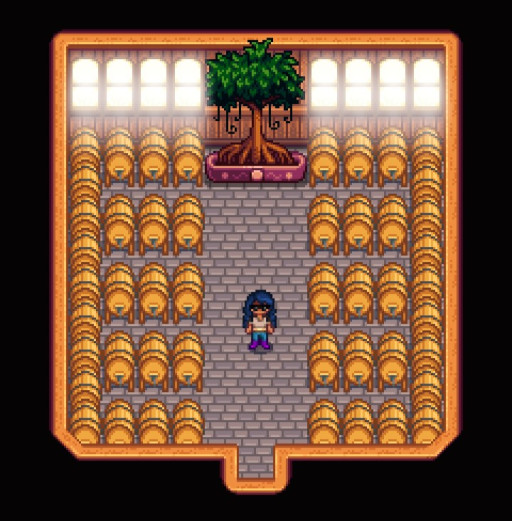
The Keg is a type of Artisan Equipment used to make Artisan Goods. It works by placing a fruit or vegetable inside to make wines, juices, and other drinks. A Keg is a reward for completing the Artisan Bundle in the Pantry or the Remixed Brewer's Bundle in the Pantry.
- Recipe Source: Farming Skill Level 8
- Crafting Ingredients: 30 Wood, 1 Copper Bar, 1 ron Bar, 1 Oak Resin
Kegs can be kept in a variety of agricultural structures:
- When properly stocked with kegs, a Shed can hold 67 of them while taking up just 21 tiles of ground. On the same amount of ground, an improved Big Shed can accommodate 137 kegs when fully loaded.
- However, a barn costs less and occupies 28 tiles of land while holding 90 kegs. Although the Deluxe Barn significantly raises the cost of construction, it has been demonstrated that it can fit 136 kegs on the same amount of land as the Original Barn.
- Even more affordable coops come in smaller sizes that allow for fewer kegs to be used per tile of external farmland.
- Cabins are the least expensive at first, take up the least amount of space (15 tiles), but can only carry 42 kegs without upgrades if the cabin is unclaimed and the parsnips and bed are allowed to stay. The expanded cabin's first level can carry 113 kegs for less money than any alternative. While the second improvement greatly increases expenses, a fully refurbished cabin can store 352 kegs, giving it the most capacity per acre of external farmland.
Fruits' base value is increased by 3 by the keg, while most vegetables' base value is increased by 2.25. Low-value, high-yield crops like corn and tomatoes are therefore more useful when they are preserved. In contrast, the keg promotes crops like melons and ancient fruit that have a significantly higher base value.
Kegs can be stored almost anywhere outside the farm. Out of the way places such as the Desert and the Railroad are best as NPCs walking through a keg will destroy it.
1-Preserves Jar
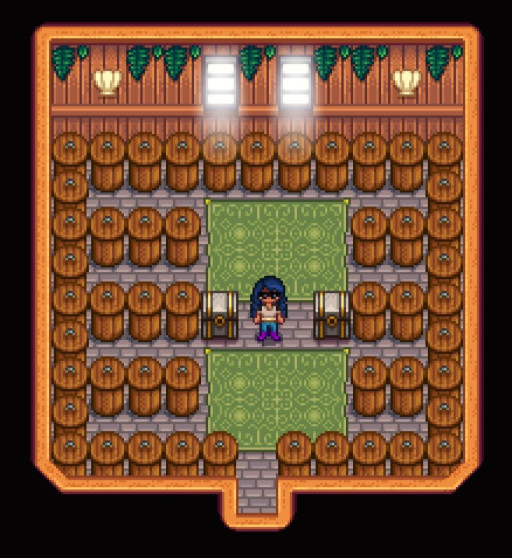
The preserves jar is a form of artisan tool used to create artisan goods. Fruits and vegetables produce jam, pickles from vegetables, caviar from sturgeon roe, and aged roe from other fish.
For completing the Quality Crops Bundle in the Pantry or the Remixed Rare Crops Bundle in the Pantry, you will receive a Preserves Jar.
- Recipe Source: Farming Skill Level 4
- Crafting Ingredients: 50 Wood, 40 Stone, 8 Coal
The end product is not affected by the quality of the ingredients. The basic value of the item—that is, its worth without a silver or gold star—is used to calculate the value of the finished product. Despite having a smaller profit margin than regular products, the preserved version is always more profitable than even gold-star produce.
Because time moves differently from 2 am to 6 am, processing timeframes should be considered as an estimate. From 6 am to 2 am, an hour is 60 minutes, but from 2 am to 6 am, an hour is 100 minutes. A whole day is 1600 minutes long, lasting 1200 minutes and the night only 400.
While Preserves Jars can be stored anywhere on the farm, it is more space efficient to store them inside farm buildings or outside the farm altogether.

